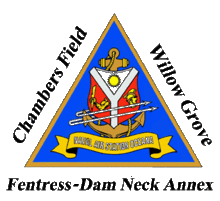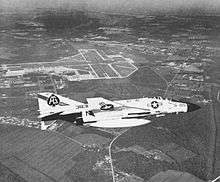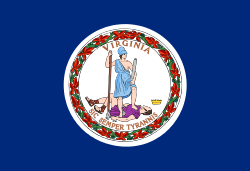Naval Air Station Oceana
| Naval Air Station Oceana Apollo Soucek Field | |||||||||||||||||||||||
|---|---|---|---|---|---|---|---|---|---|---|---|---|---|---|---|---|---|---|---|---|---|---|---|
 | |||||||||||||||||||||||
| IATA: NTU – ICAO: KNTU – FAA LID: NTU | |||||||||||||||||||||||
| Summary | |||||||||||||||||||||||
| Airport type | Naval air station | ||||||||||||||||||||||
| Owner |
| ||||||||||||||||||||||
| Operator |
| ||||||||||||||||||||||
| Location | Virginia Beach, Virginia, U.S. | ||||||||||||||||||||||
| Built | 1943 | ||||||||||||||||||||||
| In use | Active | ||||||||||||||||||||||
| Commander | CAPT Richard J. Meadows, USN | ||||||||||||||||||||||
| Coordinates | 36°49′14″N 76°02′00″W / 36.82056°N 76.03333°W | ||||||||||||||||||||||
| Runways | |||||||||||||||||||||||
| |||||||||||||||||||||||
Naval Air Station Oceana or NAS Oceana (IATA: NTU, ICAO: KNTU, FAA LID: NTU) is a military airport located in Virginia Beach, Virginia, and is a United States Navy Master Jet Base. It is also known as Apollo Soucek Field, named after Lieutenant (later Admiral) Apollo Soucek, a Navy Test Pilot who set the global altitude record in 1930 by flying a Curtiss "Hawk" biplane to an altitude of 43,166 feet. NAS Oceana is the only Master Jet Base on the East Coast.
In the summer, the Military Aviation Museum in Virginia Beach operates bus tours of the station, including the Aviation Historical Park inside the main gate.[2][3]
History
In 1940, the U.S. Navy acquired the land that would eventually become Naval Air Station Oceana. At that time, the surrounding area was mainly farmland susceptible to flooding, but it served as a useful outlying field for the rapidly expanding Naval Air Force centered at NAS Norfolk and allowed units to work up for deployments away from the crowded base there. Airspace and airfield facility restrictions precluded NAS Norfolk from serving as the home station for tactical air units, and in the 1950s NAS Oceana was expanded to Master Jet Base-status to serve that purpose. NAS Oceana has grown to become one of the largest and most advanced air stations in the world, comprising 6,820 acres (including Dam Neck Annex). Obstruction clearances and flight easements total an additional 3,680 acres (14.9 km2). Its four runways, three measuring 8,000 feet (2,400 m) in length and one measuring 12,000 feet, are designed for high-performance aircraft. NAS Oceana's primary mission is to train and deploy the Navy's Atlantic Fleet strike fighter squadrons of F/A-18 Hornets and Super Hornets. Naval Aviators and Naval Flight Officers stationed at NAS Oceana fly approximately 219,000 training operations each year.

Under the Navy's Master Jet Base concept, all Type/Model/Series (T/M/S) aircraft were homebased at one field with associated intermediate maintenance and training facilities. In the 1960s, NAS Oceana became the home to all East Coast based F-4 Phantom II squadrons. Fighter Squadron 101 (VF-101) established a detachment at NAS Oceana in its role as the Fleet Readiness Squadron (FRS), formerly known as the Replacement Air Group or "RAG", that trained aircrews and maintainers to operate the Phantom (at the time, VF-101 operated out of NAS Key West, Florida). After the F-14 Tomcat arrived on the scene in 1976, VF-101 transitioned to Tomcat operations and Phantom training operations shifted to newly established Fighter Squadron 171 (VF-171) to handle Atlantic Fleet training for the F-4 Phantom until it was retired from service in 1984. The last F-14 was retired on 22 September 2006. At one time, in addition to fighter aircraft, all of the Atlantic Fleet's A-6 Intruder medium attack squadrons were also home-based at NAS Oceana, along with VA-42 as the associated Fleet Readiness Squadron charged with training all east coast A-6 pilots, bombardier/navigators and A-6 maintenance personnel. The A-6E was retired from the Fleet in 1997.
Additionally, NAS Oceana became home to the F/A-18 Hornet in 1999 following the Navy's closure of NAS Cecil Field, Florida as part of the Base Realignment and Closure (BRAC) process.
Aside from its military function, NAS Oceana was an alternative landing site for NASA's Space Shuttle until the program ended in 2011.
On April 6, 2012 an F/A-18D assigned to VFA-106 took off from Naval Air Station Oceana, encountered dual engine failure and crashed into an apartment complex in Virginia Beach, Virginia. Both pilots ejected safely, and there were no fatalities.
Current operations
_Greg_Tetro_breaks_the_rear_glass_of_an_automobile_to_res.jpg)
Home to seventeen strike fighter squadrons of F/A-18 Hornets and F/A-18 Super Hornets, the base is the sole East Coast Master Jet Base and home to all the east coast strike-fighter (VFA) units (excluding VFA-86 and Marine Corps VMFA squadrons). Training is conducted by VFA-106 Gladiators in their F/A-18A-D Hornets and F/A-18E/F Super Hornets.
Tomcat training was conducted by VF-101 Grim Reapers. NAS Oceana was host to the "Tomcat Sunset" reunion from 21–23 September 2006, where over 3000 former and current aircrew and maintainers came together to celebrate the retirement of the F-14 from active Fleet service. NAS Oceana also was the location where the F-14 took off for the last time for final flight of the type when F-14D, Bureau Number (BuNo) 164603, Modex 101, of Fighter Squadron 31 (VF-31) was ferried from NAS Oceana to Calverton on Long Island, NY for permanent static display at the Northrop Grumman facilities where the Tomcat was originally built.
During the 2005 round of BRAC base closures, it was decided that NAS Oceana could remain open only if certain conditions were met. The most contentious of these requirements was that the city of Virginia Beach buy and condemn approximately 3,400 residences and an unknown number of businesses in crash zones surrounding the base. The BRAC commission proposed moving the fighters to Cecil Field, a recently deactivated naval air station located near Jacksonville, Florida if NAS Oceana was not able to meet that and several other conditions. The plan was initially met with optimism by Jacksonville Mayor John Peyton, even though Cecil Field had already been converted into a joint civil-military airport with helicopter operations by the U.S. Coast Guard and the Florida Army National Guard and an associated commerce park dominated by major aerospace firms such as Northrop Grumman and Boeing performing major maintenance and overhaul work on a variety of military jet aircraft. The senior Navy leadership ultimately expressed disinterest in moving the Master Jet Base back to the Jacksonville area, having only deactivated Cecil Field less than six years earlier and moving all its Atlantic Fleet F/A-18 squadrons from the former NAS Cecil Field to NAS Oceana. In October 2005, the city of Jacksonville removed itself from the process.
On 20 December 2005 the Virginia Beach City Council passed numerous ordinances enacted to satisfy BRAC, but did not act to condemn any of the homes in the designated areas. In a November 2006 referendum, citizens of Jacksonville voted to leave the Cecil Field Airport and Commerce Center in civilian hands under the Jacksonville Aviation Authority, effectively halting any future plans of relocation.
In addition to the squadrons listed, there are numerous other commands present as "tenant" commands at Oceana:
- Fleet Readiness Center Mid-Atlantic, formerly known as Aviation Intermediate Maintenance Department (AIMD) Oceana. One of six centers for naval aviation maintenance, FRC provides Intermediate and Depot level maintenance support to the tenant squadrons and SeaOpDet technicians to aircraft carriers homeported on the East Coast.
- Strike Fighter Wing Atlantic, the command that serves as "Commodore" of all east coast Hornet and Super Hornet squadrons when not forward deployed with their respective carrier air wings.
- Strike Fighter Weapons School Atlantic (SFWSL) a Type Weapons School staffed by Strike Fighter Weapons & Tactics (SFWTI) instructors where F/A-18 aircrews go for "graduate level" training in air-to-ground ordnance delivery and air-to-air tactics.
- Landing Signal Officer School (LSO School), where pilots selected to be LSOs (also known as "paddles"...which is a very old term from the days when the LSO actually signaled to the approaching aircraft with brightly colored paddles) go to learn how to "wave" planes aboard the "boat" (aircrew speak for the aircraft carrier).
- CVW commands, or Carrier Air Wing Commanders (also called CAG, which is an old term derived from the previous name for these commands, Carrier Air Groups), which are responsible for all squadrons in an air wing when actually on board a carrier or when preparing for overseas deployment. Carrier Air Wings One, Three, Seven, and Eight maintain headquarters at NAS Oceana.
- Strike Fighter Composite Squadron 12 (VFC-12), a Navy Reserve F/A-18A+ Hornet squadron that provides adversary/aggressor training services to Atlantic Fleet strike fighter squadrons.
- Fleet Logistics Support Squadron 56 (VR-56), a Navy Reserve C-40 squadron that provides worldwide operational support airlift for deployable U.S. Navy Fleet units and shore establishment commands.
- Fleet Area Control and Surveillance Facility Virginia Capes (FACSFAC VACAPES, callsign GIANT KILLER), which is responsible for surveillance, management and sea and air traffic control of the Virginia Capes warning areas for training purposes, as well as surveillance duties in support of Homeland Defense.
- Construction Battalion Unit 415 (CBU 415), a Navy Seabee Battalion.
- Center for Naval Aviation Technical Training Unit Oceana (CNATTU Oceana), which trains Navy and Marine Corps aircraft maintainers on the F/A-18 and operates both A and C schools.
- Marine Aviation Training Support Group 33, a United States Marine Corps training administration command, primarily supporting USMC aviation student and instructor staff personnel assigned to the F/A-18 Fleet Readiness Squadron, VFA-106.
- A branch Medical and Dental clinic under the command of Naval Medical Center Portsmouth, VA.
Outlying field controversy
Plans by the Navy to construct an outlying landing field supporting both NAS Oceana and MCAS Cherry Point in eastern North Carolina, initiated in 2006, met with fierce opposition by local residents and environmentalists. Concerns about the ecological impacts of the field, along with noise concerns voiced by residents,[4][5] led to the abandonment of the initially planned sites for the OLF,[6] along with a delay in the project's environmental impact statement.[7][8]
In early 2011, the U.S. Navy announced it was suspending plans for the construction of the outlying landing field until at least 2014.[9]
Tenant Squadrons
Carrier Wings
Strike Fighter Wing Atlantic
- Carrier Air Wing 1 (CVW-1), assigned to: USS Theodore Roosevelt (CVN-71)
- Carrier Air Wing 3 (CVW-3), assigned to: USS Harry S. Truman (CVN-75)
- Carrier Air Wing 7 (CVW-7), assigned to: USS Dwight D. Eisenhower (CVN-69)
- Carrier Air Wing 8 (CVW-8), assigned to: USS George H.W. Bush (CVN-77)
| F/A-18A+/B/C/D Hornets | F/A-18E/F Super Hornets | Boeing C-40 Clipper |
|---|---|---|
|
Related
- Skytypers Air Show Team (fatal accident September 7, 2007)
References
- ↑ FAA Airport Master Record for NTU (Form 5010 PDF)
- ↑ "Visitor Information". Naval Air Station Oceana. Retrieved 10 October 2015.
- ↑ "Tours". Military Aviation Museum. Retrieved 10 October 2015.
- ↑ "North Carolinians Opposed to the Outlying Landing Field". Noolf.com. Retrieved 2012-04-28.
- ↑ OLFEIS | Navy Outlying Landing Field Environmental Impact Statement Archived February 1, 2011, at the Wayback Machine.
- ↑ The next Oceana?
- ↑ Hampton, Jeff (28 January 2011). "Navy scraps plan for jet landing field until at least 2014". The Virginian-Pilot. Norfolk, VA. Retrieved 29 September 2011.
External links
| Wikimedia Commons has media related to Naval Air Station Oceana. |
- NAS Oceana (official site)
- NAS Oceana Jet Observer, the military-authorized newspaper
- Naval Air Station Oceana Global Security.org. Retrieved 27 October 2006
- Naval Auxiliary Landing Field Fentress Retrieved 14 March 2007
- KNTU Oceana Naval Air Station Air Nav.com Retrieved 27 October 2006
- Extensive Photo Report from Oceana Air Shows
- NAS Oceana Installation Overview from NavyUSA.org
- Tomcat Sunset Information
- FAA Airport Diagram (PDF), effective December 8, 2016
- FAA Terminal Procedures for NTU, effective December 8, 2016
- Resources for this U.S. military airport:
- FAA airport information for NTU
- AirNav airport information for KNTU
- ASN accident history for NTU
- NOAA/NWS latest weather observations
- SkyVector aeronautical chart for KNTU
_and_VF-31_conduct_a_flyover_of_Naval_Air_Station_Oceana_airfield.jpg)

